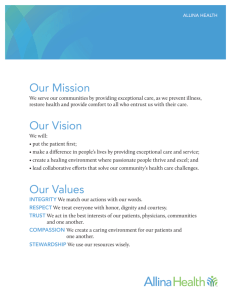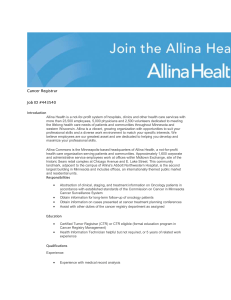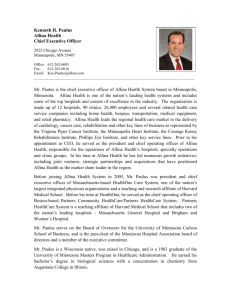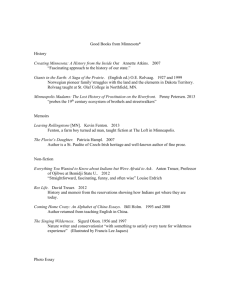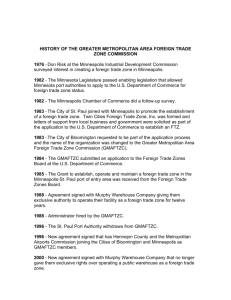CHP SUBJECT MATTER COMMUNITY SPOTLIGHT COMMUNITY OVERVIEW
advertisement
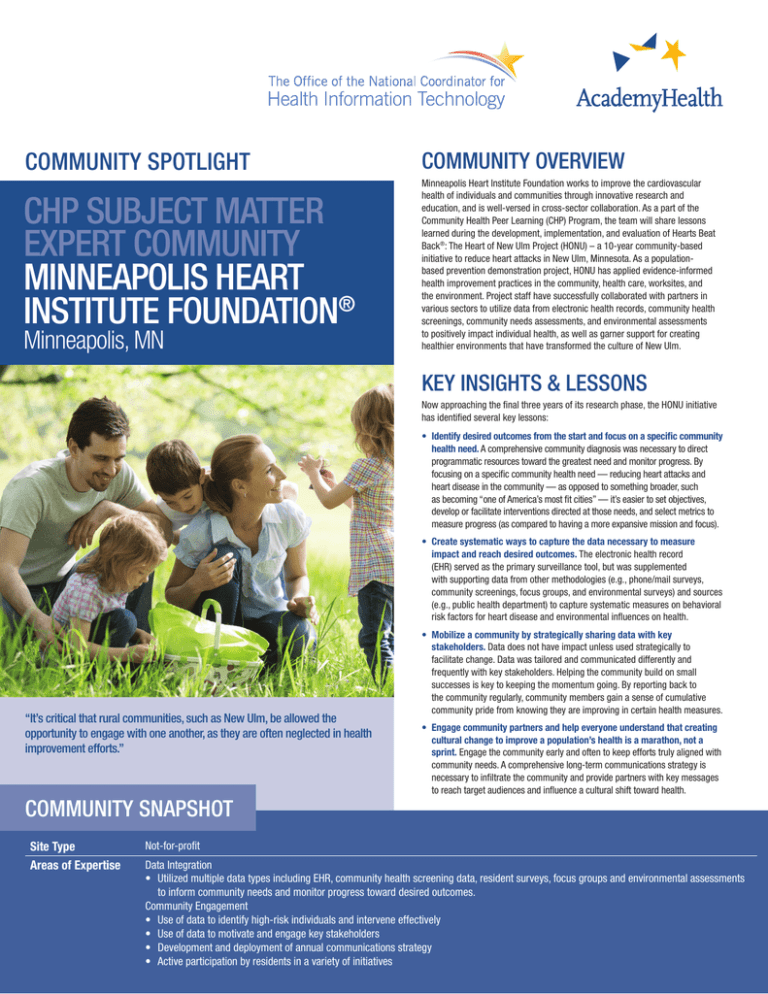
COMMUNITY SPOTLIGHT COMMUNITY OVERVIEW CHP SUBJECT MATTER EXPERT COMMUNITY MINNEAPOLIS HEART INSTITUTE FOUNDATION® Minneapolis Heart Institute Foundation works to improve the cardiovascular health of individuals and communities through innovative research and education, and is well-versed in cross-sector collaboration. As a part of the Community Health Peer Learning (CHP) Program, the team will share lessons learned during the development, implementation, and evaluation of Hearts Beat Back®: The Heart of New Ulm Project (HONU) – a 10-year community-based initiative to reduce heart attacks in New Ulm, Minnesota. As a populationbased prevention demonstration project, HONU has applied evidence-informed health improvement practices in the community, health care, worksites, and the environment. Project staff have successfully collaborated with partners in various sectors to utilize data from electronic health records, community health screenings, community needs assessments, and environmental assessments to positively impact individual health, as well as garner support for creating healthier environments that have transformed the culture of New Ulm. Minneapolis, MN KEY INSIGHTS & LESSONS Now approaching the final three years of its research phase, the HONU initiative has identified several key lessons: • Identify desired outcomes from the start and focus on a specific community health need. A comprehensive community diagnosis was necessary to direct programmatic resources toward the greatest need and monitor progress. By focusing on a specific community health need — reducing heart attacks and heart disease in the community — as opposed to something broader, such as becoming “one of America’s most fit cities” — it’s easier to set objectives, develop or facilitate interventions directed at those needs, and select metrics to measure progress (as compared to having a more expansive mission and focus). • Create systematic ways to capture the data necessary to measure impact and reach desired outcomes. The electronic health record (EHR) served as the primary surveillance tool, but was supplemented with supporting data from other methodologies (e.g., phone/mail surveys, community screenings, focus groups, and environmental surveys) and sources (e.g., public health department) to capture systematic measures on behavioral risk factors for heart disease and environmental influences on health. “It’s critical that rural communities, such as New Ulm, be allowed the opportunity to engage with one another, as they are often neglected in health improvement efforts.” COMMUNITY SNAPSHOT • Mobilize a community by strategically sharing data with key stakeholders. Data does not have impact unless used strategically to facilitate change. Data was tailored and communicated differently and frequently with key stakeholders. Helping the community build on small successes is key to keeping the momentum going. By reporting back to the community regularly, community members gain a sense of cumulative community pride from knowing they are improving in certain health measures. • Engage community partners and help everyone understand that creating cultural change to improve a population’s health is a marathon, not a sprint. Engage the community early and often to keep efforts truly aligned with community needs. A comprehensive long-term communications strategy is necessary to infiltrate the community and provide partners with key messages to reach target audiences and influence a cultural shift toward health. Site Type Not-for-profit Areas of Expertise Data Integration • Utilized multiple data types including EHR, community health screening data, resident surveys, focus groups and environmental assessments to inform community needs and monitor progress toward desired outcomes. Community Engagement • Use of data to identify high-risk individuals and intervene effectively • Use of data to motivate and engage key stakeholders • Development and deployment of annual communications strategy • Active participation by residents in a variety of initiatives KEY ACHIEVEMENTS LEAD AGENCY • EHR Integration: Close partnerships with Allina Health and the New Ulm • The Minneapolis Heart Institute Foundation (http://mplsheart.org) aims to • Community Engagement: Within the first year, there was a 94 percent PARTNERS/COLLABORATORS Medical Center allowed HONU to access electronic health records for nearly everyone within their target population. Electronic health records were integrated into several HONU activities, including the HeartBeat Connections telephonic coaching program and community heart-health screenings. awareness of the HONU in the community. This awareness level has remained consistent throughout the last seven years and 99 percent of residents say maintaining health is an important value. • Measureable Impact: Significant improvements in blood pressure, LDL-C, and glucose have been observed over 5 years, while BMI has remained stable. Behavioral improvements have been seen in fruit and vegetable intake, physical activity level, and smoking cessation. HONU is committed to sharing its findings so that other communities can benefit. To date, this initiative has published 15 journal articles, created 16 research posters, and made 28 presentations nationally. create a world without heart and vascular disease by focusing on improving the cardiovascular health of individuals and communities through innovative research and education. • Allina Health: A nonprofit health system, Allina Health cares for patients from beginning to end-of-life through its clinics, hospitals, pharmacies, and specialty medical services. They are dedicated to the prevention and treatment of illness and enhancing the greater health of individuals, families, and communities throughout Minnesota and western Wisconsin. • New Ulm Medical Center (NUMC): Part of the Allina Health system, NUMC is a nonprofit hospital and clinic serving the region in and around Brown County, located in south central Minnesota. • New Ulm, Minn.: New Ulm is located in the south central part of Minnesota, approximately 100 miles southwest of the Twin Cities. This rural city has one hospital and clinic, and more than 90 percent of the population has data within the EHR at NUMC. MEET THE PROJECT TEAM! Rebecca Lindberg, M.P.H., R.D. Director Population Health, Minneapolis Heart Institute Foundation CHP Role: Advisor Contact: rlindberg@mhif.org Ask her about: Gretchen Benson, R.D.N., C.D.E. Manager Healthcare Systems Integration, Minneapolis Heart Institute Foundation CHP Role: Project Manager Contact: gbenson@mhif.org Ask her about: Abbey Sidebottom, Ph.D., M.P.H. Managing Scientist, Allina Health CHP Role: Advisor Contact: Abbey.Sidebottom@allina.com Ask her about: Melissa Hanson, M.B.A. Director Marketing and Public Relations, Minneapolis Heart Institute Foundation CHP Role: Marketing Contact: mhanson@mhif.org Ask her about: • Designing and deploying communications strategy for engagement • Using data effectively to engage the community and key stakeholders • Utilizing EHR data to conduct community screenings and programming • Using data effectively to reach those at increased risk • Utilizing the EHR as a surveillance tool for population health monitoring and measurement • Disseminating findings through media COMMUNITY HEALTH PEER LEARNING PROGRAM www.academyhealth.org/CHPhealthIT
